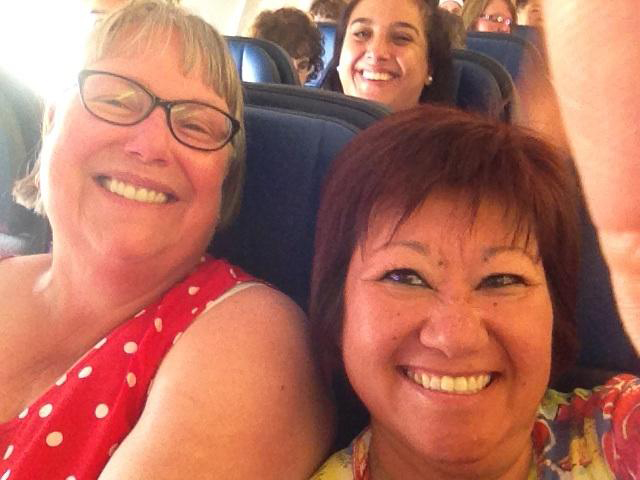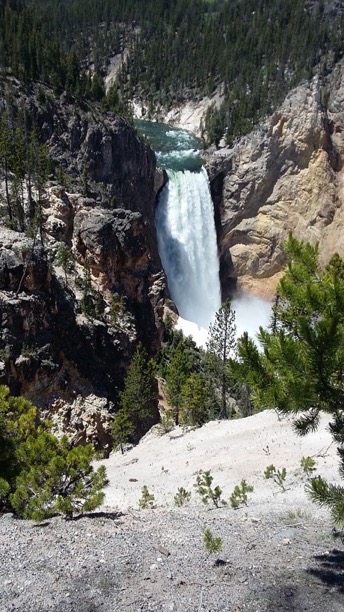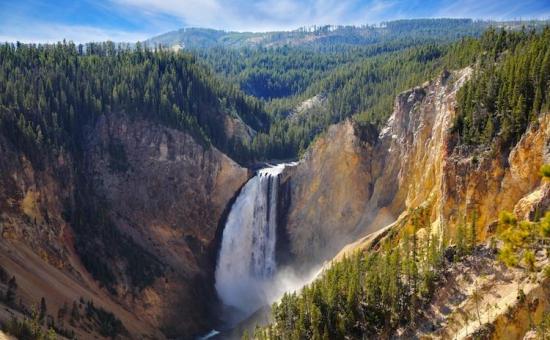Guest blog: ISTA members traverse Yellowstone
07/29/2016
Two ISTA members joined an educational trip to Yellowstone National Park. Sanae Glendening [pictured R], second grade teacher at Meadows Elementary and Sherrie Huang [pictured L], kindergarten teacher at Ox Bow Elementary share their story, photos and how they plan to use their experience in the classroom.
Edited by Kara Seward
Fourteen Hoosier K-12 teachers have returned from an AWESOME ten-day educational study adventure at Yellowstone National Park.
We learned about the interactions of economic, environmental and political systems. We saw geological phenomenon, visited geographic features and watched beautiful wildlife that will provide a lifetime of memories.

After a flight and drive to reach Yellowstone on day one, the adventure began! On day two, the group met at the Yellowstone Economic Education Center to begin our study of the complex economic, environmental and ecosystems of the park system before going into Yellowstone for the first time. This helped us focus more on the experience and its application in the classroom.
We continued on to one of the park highlights, Old Faithful. We watched it erupt and hiked around the area to see other geysers and fumaroles before visiting the Old Faithful Lodge.
On day three, we went to Lake Hebgen and met with a representative from the Buffalo Field Campaign, an organization that works to prevent threats to free-roaming buffalo. We learned about different types of rock in the area, especially the obsidian, which is also known as volcanic glass. We enjoyed lunch in a picnic area overlooking a beautiful scenic area.
After visiting the Quake Lake Visitor Center and learning about the 1959 earthquake and landslide that created a 6-mile long lake, we had the good fortune of meeting a gentleman who lived through it who shared his experience with us. It was remarkable to hear the official story and then have it related personally.
On day four, we talked winter, weather and wages. We met with the owner of 3 Bear Lodge in West Yellowstone, where we were staying. We heard from a park ranger who oversees fire management and talked to us about how natural, weather related fires are actually good for the park. Our third speaker talked about how the seasonal Yellowstone business impacts the gateway city economies.

Day five had us wandering through wonderful waterfalls and canyons. While hiking along the Grand Canyon of Yellowstone, we were able to view both the upper and lower waterfalls. The views were breathtaking!
The following day, we traveled to Gardiner, Mont. As we travelled, we participated in discussions about what we had experienced so far and shared the fun of the trip. A representative from the Bear Creek Council, a group that works with park officials to conserve and protect Yellowstone’s natural resources, spoke to us about the current wildlife in the park and some of their history.
Day seven took us to see volcanoes, valleys and vapors. Going into the Lamar Valley, we were able to see many more geothermal features and more wildlife. It is amazing to realize that this area has developed due to being located on top of a volcanic area.
A local wildlife guide took us out on the morning of the eighth day. We were able to see wolves near their den, mountain goats and a grizzly bear (from a safe distance!). We looked for badgers, bald eagles and more, but luck wasn’t on our side.
On day nine we talked about wildlife conservation. We met with rangers who talked about bison, elk and wolves and how the populations have changed over the years. We learned how this impacts the number of other wildlife as well as the number of visitors to the park. Doug Smith, the biologist in charge of managing wolves at Yellowstone, shared the picture of him from the May 2016 issue of National Geographic magazine.
We visited a nearby cattle ranch and heard how their location near the park has brought concerns of disease transmitted by bison or elk. We hadn’t considered the impacts of wildlife on the domesticated animals.
On day ten, the adventure was over. We’re already planning to get together again soon and begin working on follow up lessons for our classes! We can’t wait to implement our new lessons and what we learned into our classrooms. What a WONDERFUL group of teachers it has been to be a part of! The next generation is in good hands!
The trip was sponsored by the Indiana State University Center for Economic Education and the Indiana Council for Economic Education. The group was under the leadership of Dr. John Conant, professor and chair, Indiana State University (ISU) Department of Economics and director of the ISU Center for Economic Education. Dr. Chris McGrew, director of the ISU Center for Global Engagement, assisted Dr. Conant.
For more information on the Indiana Council for Economic Education and professional development opportunities from them, visit their website.
